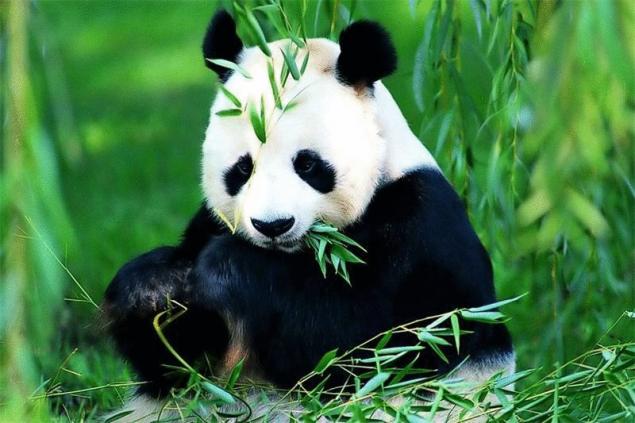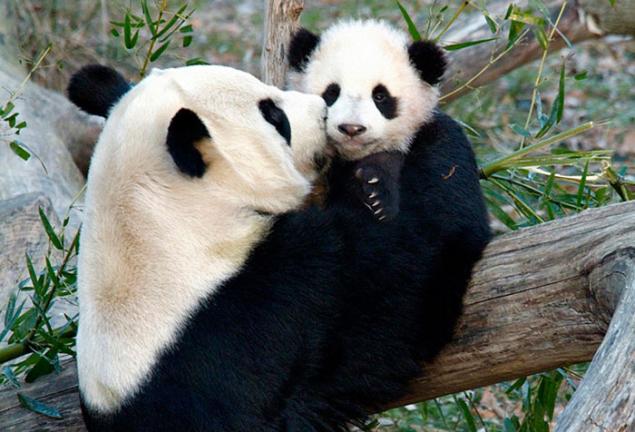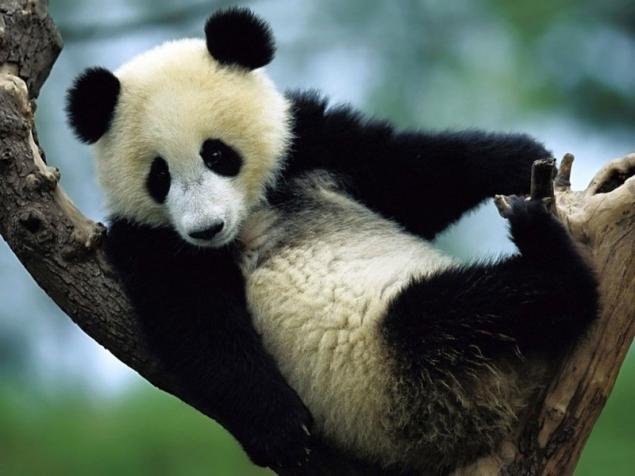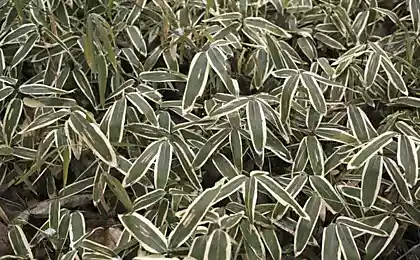527
How pandas survive on a plant-based diet
The digestive system of pandas, peculiar to carnivores, can not properly treated Mature bamboo, so pandas have to constantly search for food, young plants.
The structure of the digestive system usually adapts to what the animal eats. To break down animal proteins better than vegetable material so predatory animals the intestine is relatively short and the stomach is designed simply compared to, for example, from ruminants, with their complex 4-chambered stomach and a long intestine.
Famous in the whole world the giant Panda belongs to the bear, that is, the original she – predator. Her digestive system is set by the evolution of predominantly meat diet. At the same time, as is well known, the giant Panda eat nothing but bamboo. It is a predator, converted to vegetarianism – this is only in children's stories is found. The question arises as Panda sits on the food and not dying from lack of nutrients.
Researchers from the Zoological Institute of the Chinese Academy of Sciences tried to find out what's going on here. Together with colleagues from Australia and the USA they are supplied with radio chips three male and three female pandas in the mountains of Tingling. For six years the animals were observed in their natural habitat, paying particular attention to what they eat and how many nutrients contained in plants, which made up the diet of pandas.

It turned out that pandas are choosy in food, giving preference to the best, most nutritious parts of the bamboo. In the mountains of Tingling there are two kinds of bamboo that grow at different heights and in which new shoots and leaves appear in different periods of the year. In the spring, when the Panda comes the breeding season, they feed on young shoots of one species of bamboo. By June the young bamboo Matures and it decreases the content of nitrogen and phosphorus pandas lose interest and go higher into the mountains, where grows another kind, which just comes a time to throw out new shoots. However, the young shoots of both species of bamboo is poor in calcium and it makes pandas in mid-July, go to fresh bamboo leaves, which are rich in calcium.
This transition with some bamboo shoots on the other, and then leaves offers an interesting feature in the reproductive cycle of giant pandas. The mating season they have, as mentioned, comes spring, but the embryo after a short period of development immersed in a short hibernation. The implantation of the embryo into the uterus and continue development occur later, and, as the authors write operation on the pages of Functional Ecology, due to the fact that the germ for the development need calcium, calcium inflow begins only in mid-summer.

In August, females come down the mountains back and give birth to cubs. At the same time they start to eat the fresh leaves of bamboo, which grows just below – they are also rich in calcium, and it is lactating females especially need. The pregnancy of giant pandas lasts only 2-3 months, whereas other bears it lasts about six months; and a baby Panda weighs 3-4 times less than those of bears of other species. This is connected, probably, with insufficient nutritional value diet of the pandas and that they have to wait for a particular season, when pregnant and lactating will eat the right foods.
In winter, however, no tricks pandas can not help. Bamboo gets older, new shoots and leaves is not formed, and pandas are in danger of death from malnutrition – from old bamboo, their digestive tract can't extract the right amount of nutrients. Indeed, according to the authors, more than half of the deaths of pandas is in March-April is the time when the lack of nutrients in the animal body reaches its peak.
However, some researchers believe that pandas can still get calcium and other important substances from other sources. For example, biologist Datsun Wang (Wang Dajun) from Peking University claims to have seen pandas that fell through; in addition, calcium and other trace elements to animals, licking the stones. But still it is unclear how such "other sources" is important in the diet of pandas.

Source: nkj.ru
The structure of the digestive system usually adapts to what the animal eats. To break down animal proteins better than vegetable material so predatory animals the intestine is relatively short and the stomach is designed simply compared to, for example, from ruminants, with their complex 4-chambered stomach and a long intestine.
Famous in the whole world the giant Panda belongs to the bear, that is, the original she – predator. Her digestive system is set by the evolution of predominantly meat diet. At the same time, as is well known, the giant Panda eat nothing but bamboo. It is a predator, converted to vegetarianism – this is only in children's stories is found. The question arises as Panda sits on the food and not dying from lack of nutrients.
Researchers from the Zoological Institute of the Chinese Academy of Sciences tried to find out what's going on here. Together with colleagues from Australia and the USA they are supplied with radio chips three male and three female pandas in the mountains of Tingling. For six years the animals were observed in their natural habitat, paying particular attention to what they eat and how many nutrients contained in plants, which made up the diet of pandas.

It turned out that pandas are choosy in food, giving preference to the best, most nutritious parts of the bamboo. In the mountains of Tingling there are two kinds of bamboo that grow at different heights and in which new shoots and leaves appear in different periods of the year. In the spring, when the Panda comes the breeding season, they feed on young shoots of one species of bamboo. By June the young bamboo Matures and it decreases the content of nitrogen and phosphorus pandas lose interest and go higher into the mountains, where grows another kind, which just comes a time to throw out new shoots. However, the young shoots of both species of bamboo is poor in calcium and it makes pandas in mid-July, go to fresh bamboo leaves, which are rich in calcium.
This transition with some bamboo shoots on the other, and then leaves offers an interesting feature in the reproductive cycle of giant pandas. The mating season they have, as mentioned, comes spring, but the embryo after a short period of development immersed in a short hibernation. The implantation of the embryo into the uterus and continue development occur later, and, as the authors write operation on the pages of Functional Ecology, due to the fact that the germ for the development need calcium, calcium inflow begins only in mid-summer.

In August, females come down the mountains back and give birth to cubs. At the same time they start to eat the fresh leaves of bamboo, which grows just below – they are also rich in calcium, and it is lactating females especially need. The pregnancy of giant pandas lasts only 2-3 months, whereas other bears it lasts about six months; and a baby Panda weighs 3-4 times less than those of bears of other species. This is connected, probably, with insufficient nutritional value diet of the pandas and that they have to wait for a particular season, when pregnant and lactating will eat the right foods.
In winter, however, no tricks pandas can not help. Bamboo gets older, new shoots and leaves is not formed, and pandas are in danger of death from malnutrition – from old bamboo, their digestive tract can't extract the right amount of nutrients. Indeed, according to the authors, more than half of the deaths of pandas is in March-April is the time when the lack of nutrients in the animal body reaches its peak.
However, some researchers believe that pandas can still get calcium and other important substances from other sources. For example, biologist Datsun Wang (Wang Dajun) from Peking University claims to have seen pandas that fell through; in addition, calcium and other trace elements to animals, licking the stones. But still it is unclear how such "other sources" is important in the diet of pandas.

Source: nkj.ru
Causes of ingrown toenail and treatment
British researchers have developed a new super-material, the type of "black hole"























